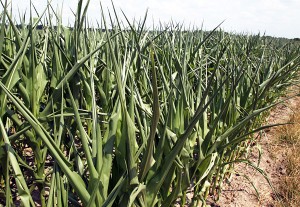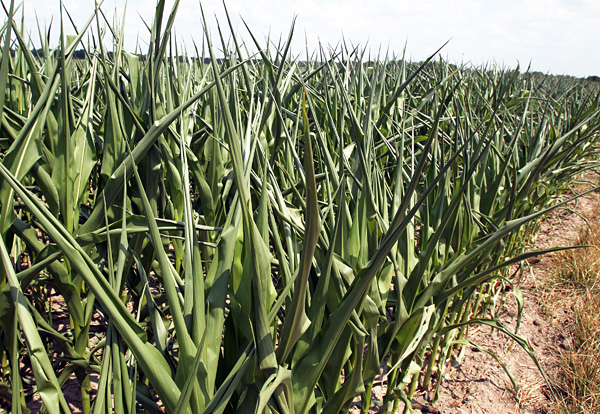 Orlan Love, CR Gazette –
Orlan Love, CR Gazette –
An August staple in Iowa — roadside seed corn signs proudly proclaiming the hybrid brand that produced the bumper crop standing tall in the fields beyond — will be less prominent than usual in this drought year of a lifetime.
“It will be interesting to see how many signs you see along fields with obvious drought damage,” said Nick Weber, a spokesman for Monsanto, one of the nation’s leading producers of hybrid seed corn.
(PHOTO: Corn growing in North Iowa in July, 2012.)
Posting seed corn signs “might not be good marketing this year,” said corn expert Roger Elmore, an agronomist with Iowa State University Extension.
The 2012 drought, the most severe and extensive since 1956, “will be the acid test for drought-tolerant traits bred into hybrid seed corn during the past 15 years,” Elmore said. “We have increased stress tolerance in corn. That’s documented. We’ll find out this year how well corn tolerates drought stress.”
Officials with Monsanto and Dupont Pioneer, another leading seed corn producer, agree that yield tests this fall — the most extensive ever conducted by either company — will help geneticists learn much about their products’ ability to perform in drought-stressed environments.
“The genetic package is definitely better than it was 10 years ago,” though the advantage is hard to quantify given variables such as soil type, soil management practices, length of growing season and rainfall patterns, said Charlie Foresman, corn product manager for Monsanto, whose flying ear logo on its flagship Dekalb product is a familiar sight to most Iowans.
Many growers will harvest enough corn to more than offset their production costs, said Jeff Schussler, a senior research manager at Pioneer Hi-bred International.
“That would not have happened in 1988” — the year of the last major Midwest drought, which occurred before the advent of hybrid corn drought-stress resistance, Schussler said.
Wayne Humphreys, 62, who farms near Columbus Junction, emphatically agrees.
His corn this year looks much healthier than it did under similar conditions in 1983 and 1988, said Humphreys, a district director of the Iowa Corn Growers Association.
Humphreys said he is in awe of the “stay-green quality of modern hybrids and their effective use of available moisture.”
Corn and soybean grower Richard Machacek, who farms in eastern Buchanan County, said he won’t know until after harvest whether his seed lived up to its drought-resistant billing.
“Given what we pay for it, it should do better,” said Machacek, 63, who for the first time this spring opened a $300 bag of seed corn, enough to plant 2.3 acres at 34,000 plants per acre.
Without drought-tolerant hybrids, Iowa farmers would be worse off than they are, said Bill Northey, secretary of the Iowa Department of Agriculture and Land Stewardship.
“When the yields are tabulated, I think most farmers will realize that,” said Northey, who farms in northwest Iowa.
Monsanto’s Foresman said this year will help plant breeders sort their germ plasm and identify traits that are most helpful under drought conditions.
Corn’s water-use efficiency has improved, and the plants are less sensitive to drought stress, said Schussler. “They can survive with less water, suffer less and hang in there in hopes of catching a rain,” he said.
Still, the rain has to come in time, which has not happened this year in broad swathes of the Corn Belt, he said.
Unlike soybeans and grain sorghum, which have a monthlong pollination window, the nature of corn’s flowering pattern dictates a one- to two-week pollination window, ISU’s Elmore said.
Modern hybrids “can silk quickly, even if they are under stress, and get some grain pollinated,” Schussler said.
Foresman and Schussler praised their hybrids’ genetic resistance to corn root worm, which enables vigorous root systems to tap available moisture to depths exceeding 6 feet.
Schussler said plant breeders could add traits that would greatly increase drought tolerance at the risk of “throttling the plant back too much under good growing conditions. “That is the balancing act,” he said.
Though the drought has certainly affected the seed growing operations of Pioneer and Monsanto, their representatives say they believe they will be able to meet next year’s demand.
“Much of our acreage is grown under irrigation and spread across a large geographic region,” Monsanto’s Foresman said.








Very interesting article. Thanks.